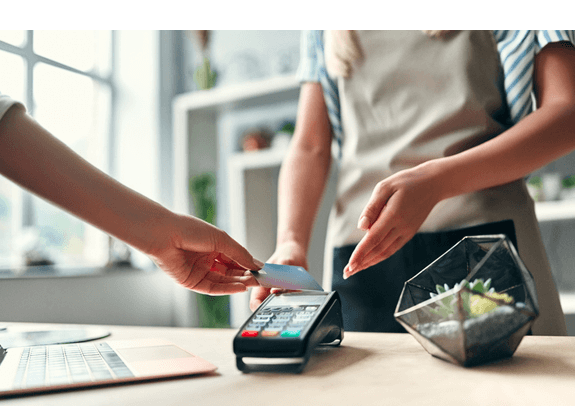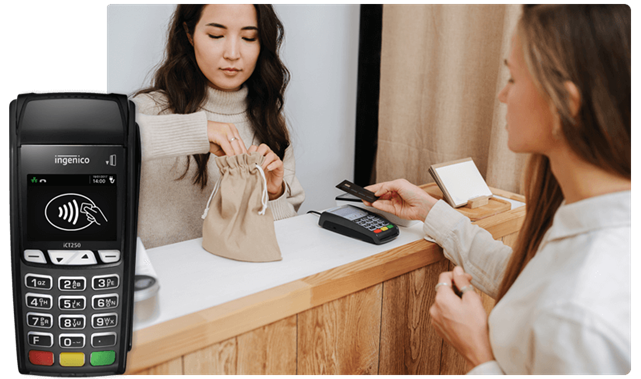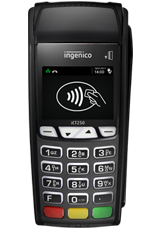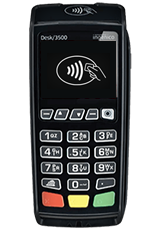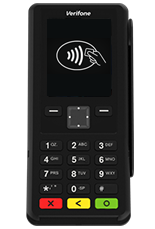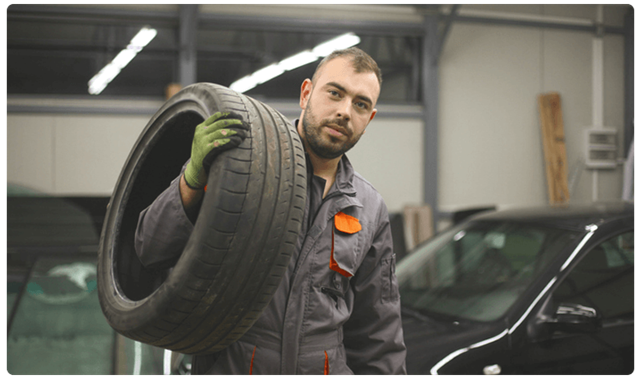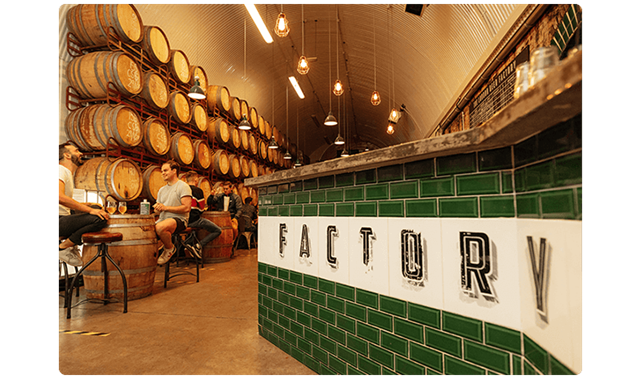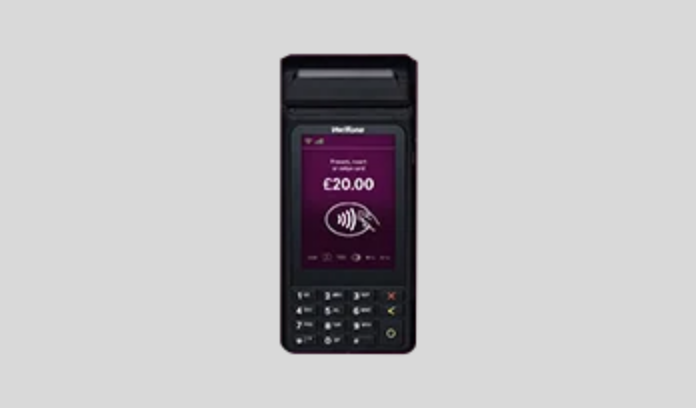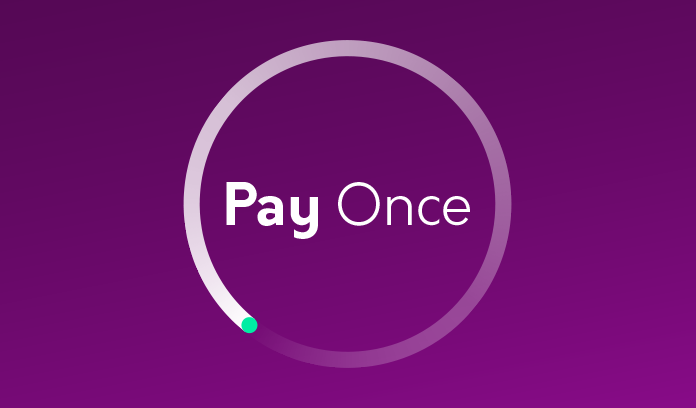Countertop card machines
If you take payments at a fixed point, then this is the best card machine for you. With a wired connection, it processes payments quickly with reliable connectivity.
What is a countertop card machine?
The benefits of a countertop card machine (also known as desktop card machine), are leveraged by businesses that have a fixed payment point. If your customers expect to pay in the same place every time they visit, be it a till, sales desk, or counter, then a fixed countertop card machine is the best option.
A countertop card machine can be connected to broadband internet (recommended) with an ethernet cable, or through a traditional phone line. Being hard-wired to a connection minimises the risk of downtime, and reliability is second to none. If you have a steady stream of customers making frequent transactions that need to be processed quickly, consider one of our countertop card machines.
-
- Stays fixed in one place
- Wired to broadband or phone line
- Reliable and fast
Reliable, fast and always there
Countertop card machines perform best in fast-paced businesses that have a high volume of card transactions and need to take payments quickly and frequently.
Ideal for newsagents, takeaways, and barbers, who typically operate with a fixed till point and need to process payments quickly before moving on to the next customer.
With a reliable connection to broadband, and technology capable of processing a payment within 2 seconds, you’ll be powering through the queues all day.
-
- Fast processing speeds
- Ideal for retailers
- High uptime
Funds from card machine to bank account in hours
Same Day Settlement, also known as 'Faster Payments', is a bolt-on feature that delivers the funds taken from card sales to your account within the same day, meaning you don't have to wait the usual 3-5 days for your money.
Having your money faster could be the difference between paying a supplier on time, restocking for your next sale, or simply keeping a healthy working capital.
-
- Get your money in hours
- No more waiting 3-5 days to settle
- Give your cash flow a boost
"We have a fixed card machine at both our venues"
"We have a fixed card machine at both of our venues, and a portable card machine for events which suits us perfectly. We switched to an RMS merchant account because it was so simple to set up, and the rates were far better than our previous payments partner. We plan to move our website payments to RMS soon because their rates are so favourable and the service is second to none”.
Sim Cotton, The London Beer Factory
Countertop card machines frequently asked questions
A countertop card machine (also known as a ‘desktop card machine’ or a ‘fixed card machine’), is used by a business that takes card payments at one or more permanent locations within their premises, without a need to carry or move the card machine around.
Imagine a newsagent, bakery or deli with a till at one end of the counter. Or a fast-food outlet, barber or dry cleaner, who has a high frequency of lower value payments consistently throughout the day.
Customers of these businesses expect to pay quickly, and in the same place. For this reason, a countertop card machine is connected using a hard-wired internet connection or a phone line, which when paired with fast processing speeds, makes the machines a reliable and no-nonsense option for small business owners.
How to spot a countertop card machine
Uses a wired connection to a phoneline or broadband
Stays fixed in one place, like next to a till
Reliable and fast
No - but you will need an internet connection.
Traditionally, countertop card machines were connected using a phoneline, and some models still have that option, but it’s not recommended because inbound and outbound calls can occupy the phoneline and interrupt the connection to the card machine.
A much better option is to connect to broadband internet using a wired (ethernet) connection. This will keep your phoneline free for customer enquiries and give your terminal a reliable connection.
A countertop card machine can be connected to the internet (recommended) or a phoneline (dependent on model).
Typically, a card machine can be connected using the following steps:
Put the card machine in a convenient place for both you and your customers.
Insert the power cable jack into the card machine power port.
Insert the power cable plug into an electrical socket and switch it on.
Insert an ethernet cable into the ethernet port on the card machine (labelled ‘ETH’).
Insert the ethernet cable into a router or wall mounted ethernet socket.
Follow the steps presented on-screen by the card machine.
If you’re using a standard telephone line connection, connect the card machine to a wall telephone socket using a standard telephone lead. This connection port is usually labelled ‘IN’.
If you’re looking to connect a specific card machine, check out our user guides.
The ‘PDQ’ in PDQ machines stands for 'Process Data Quickly'. It's an obsolete term for the modern-day card machines, card readers or chip and PIN machines that we use in everyday life.
Some business owners (and customers) still use the name 'PDQ machines', and this isn’t wrong, it’s just a different way of saying the same thing, like 'wireless' instead of 'radio'. Ultimately the function remains: a device to take payment from a credit or debit card.
A traditional PDQ machine would accept payment by swiping the customer's card down the side of the machine. The payment was then authorised when the customer physically signed a printed receipt and handed it back to the merchant, who would check the two signatures matched.
This technology was replaced by chip and PIN for its obvious security benefits. Previously, a criminal could simply practice the signature of a lost or stolen card to use it fraudulently.
Here are 3 ways you can take credit card payments without a physical card machine:
Through your website, using an online payment gateway
Send your customers a pay by link to a secure payment page
Over the phone, using a virtual terminal
Payment Gateway – online, through your website
Accept online card payments through your website with a payment gateway that connects to your chosen shopping cart. Once users have selected or reserved their product or service, they can be either directed to a hosted payment page or use a payment form that’s built directly into your website through an integration.
Pay by Link – through any device with a web browser
Send your customers a unique URL (payment link) by email, WhatsApp, SMS or social messaging to initiate a payment request for a specific, outstanding amount, without the need for a website of your own. The link will direct them to a payment page hosted by us, accessible through any device with a web browser. From here, they can enter their card details like they would pay for any other product or service over the internet.
Virtual terminal – over the phone
This is effectively an online card machine, accessible through your laptop, phone, or tablet. Simply login to our portal where you can enter the payment amount and customer’s details whilst they recite them to you over the phone. This can also be useful for companies dealing with mail orders.
In order to start an application for a card machine, we need some proof that it's being used for business purposes.
As a provider of POS and payments solutions, it’s important that we can identify and verify who our users are, for the financial safety of us, our associated acquiring banks, and the applicant’s customers.
To begin an application we start by asking for the following documents:
Photo ID
A current and valid passport or Driving Licence ID.
Proof of business
A utility bill* showing both the trading name and trading address or a lease agreement signed by the merchant and the landlord. Invoices are not accepted.
Proof of business banking*
A voided cheque, paying in slip, bank statement or welcome letter. Documentation must have an account name, sort code, account number and bank logo.
Proof of address*
A home utility bill, personal bank statement or credit card statement.
*Documentation must be dated within the last 6 months.
Note: You may be asked for additional documentation further into the application process. What you need to provide may differ depending on your business type (sole trader or a limited company).
If the information on the documents does not coincide with the information on the application, we may contact you for further clarification.

